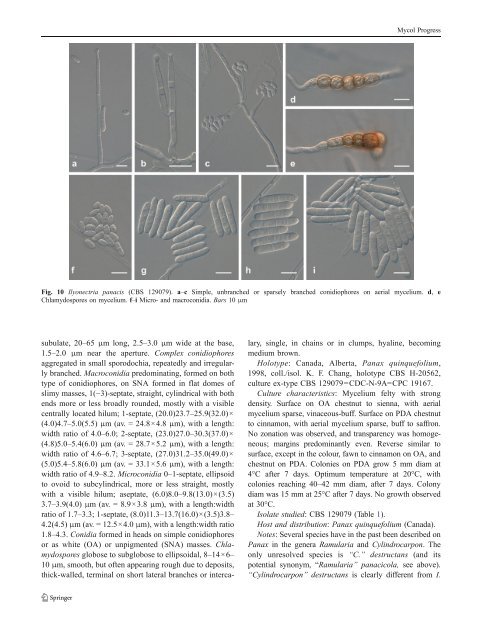Cylindrocarpon root rot: multi-gene analysis reveals novel ... - CBS
Cylindrocarpon root rot: multi-gene analysis reveals novel ... - CBS
Cylindrocarpon root rot: multi-gene analysis reveals novel ... - CBS
You also want an ePaper? Increase the reach of your titles
YUMPU automatically turns print PDFs into web optimized ePapers that Google loves.
Mycol ProgressFig. 10 Ilyonectria panacis (<strong>CBS</strong> 129079). a–c Simple, unbranched or sparsely branched conidiophores on aerial mycelium. d, eChlamydospores on mycelium. f–i Micro- and macroconidia. Bars 10 μmsubulate, 20–65 μm long, 2.5–3.0 μm wide at the base,1.5–2.0 μm near the aperture. Complex conidiophoresaggregated in small sporodochia, repeatedly and irregularlybranched. Macroconidia predominating, formed on bothtype of conidiophores, on SNA formed in flat domes ofslimy masses, 1(−3)-septate, straight, cylindrical with bothends more or less broadly rounded, mostly with a visiblecentrally located hilum; 1-septate, (20.0)23.7–25.9(32.0)×(4.0)4.7–5.0(5.5) μm (av.=24.8×4.8μm), with a length:width ratio of 4.0–6.0; 2-septate, (23.0)27.0–30.3(37.0)×(4.8)5.0–5.4(6.0) μm (av.=28.7×5.2μm), with a length:width ratio of 4.6–6.7; 3-septate, (27.0)31.2–35.0(49.0)×(5.0)5.4–5.8(6.0) μm (av.=33.1×5.6μm), with a length:width ratio of 4.9–8.2. Microconidia 0–1-septate, ellipsoidto ovoid to subcylindrical, more or less straight, mostlywith a visible hilum; aseptate, (6.0)8.0–9.8(13.0)×(3.5)3.7–3.9(4.0) μm (av. = 8.9×3.8 μm), with a length:widthratio of 1.7–3.3; 1-septate, (8.0)11.3–13.7(16.0)×(3.5)3.8–4.2(4.5) μm (av. = 12.5×4.0 μm), with a length:width ratio1.8–4.3. Conidia formed in heads on simple conidiophoresor as white (OA) or unpigmented (SNA) masses. Chlamydosporesglobose to subglobose to ellipsoidal, 8–14×6–10 μm, smooth, but often appearing rough due to deposits,thick-walled, terminal on short lateral branches or intercalary,single, in chains or in clumps, hyaline, becomingmedium brown.Holotype: Canada, Alberta, Panax quinquefolium,1998, coll./isol. K. F. Chang, holotype <strong>CBS</strong> H-20562,culture ex-type <strong>CBS</strong> 129079=CDC-N-9A=CPC 19167.Culture characteristics: Mycelium felty with strongdensity. Surface on OA chestnut to sienna, with aerialmycelium sparse, vinaceous-buff. Surface on PDA chestnutto cinnamon, with aerial mycelium sparse, buff to saffron.No zonation was observed, and transparency was homo<strong>gene</strong>ous;margins predominantly even. Reverse similar tosurface, except in the colour, fawn to cinnamon on OA, andchestnut on PDA. Colonies on PDA grow 5 mm diam at4°C after 7 days. Optimum temperature at 20°C, withcolonies reaching 40–42 mm diam, after 7 days. Colonydiam was 15 mm at 25°C after 7 days. No growth observedat 30°C.Isolate studied: <strong>CBS</strong> 129079 (Table 1).Host and distribution: Panax quinquefolium (Canada).Notes: Several species have in the past been described onPanax in the <strong>gene</strong>ra Ramularia and <strong>Cylindrocarpon</strong>. Theonly unresolved species is “C.” destructans (and itspotential synonym, “Ramularia” panacicola, see above).“<strong>Cylindrocarpon</strong>” destructans is clearly different from I.
















